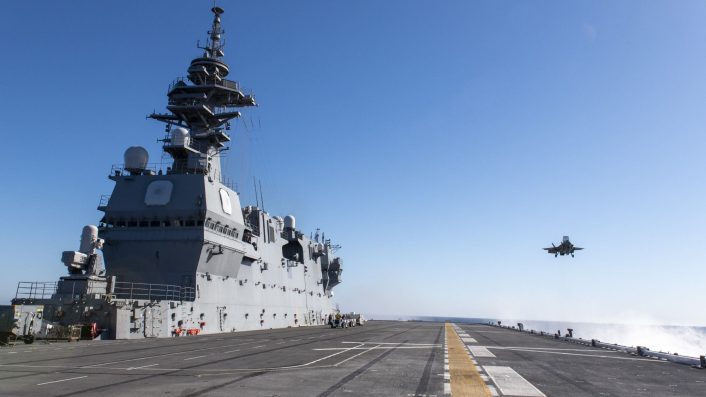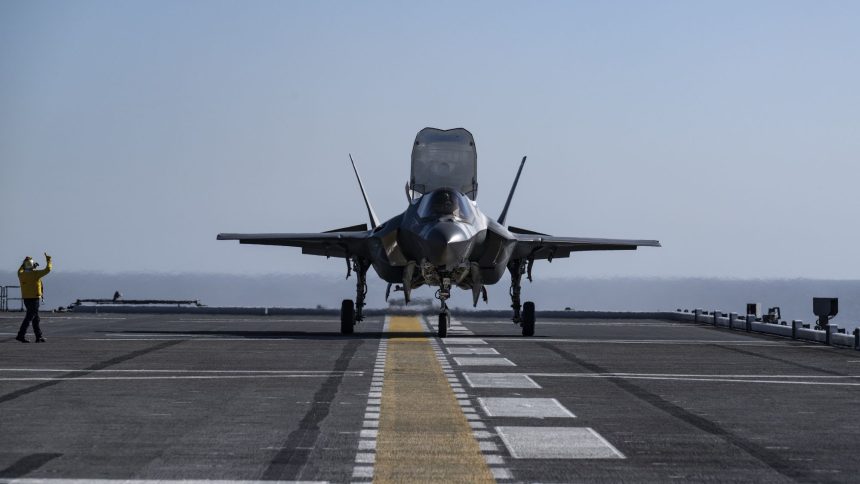The JS Kaga’s flight deck was modified to operate the F-35B and be used as a ‘Lightning Carrier’. The tests off the southern coast of California also pave the way for an increased interoperability between Japan and the U.S., strengthening the deterrence and response capabilities of the alliance.
Trials of the F-35B on the JMSDF (Japan Maritime Self-Defense Force) JS Kaga finally began on Oct. 20, 2024, off the coast of southern California, as the STOVL (Short Take-Off Vertical Landing) jet landed on the helicopter carrier for the first time. The Kaga’s flight deck was modified to be used as a “Lightning Carrier” and operate this version of the stealth fighter, as Japan awaits the delivery of its F-35B aircraft and studies its operations from other navies who already operate the type.
The JS Kaga reached San Diego naval base under foggy conditions on Oct. 5, after setting sail from its homeport at Kure Naval Base early in September. The ship sailed out on Oct. 19 from San Diego to prepare for the trials, which are scheduled to last approximately three weeks.
F-35Bが現地時間10月20日15時ごろ、初の着艦に成功!!🛩⚓ @USNavy @USMC
矩形の飛行甲板となった護衛艦「#かが」は #F35B の艦上運用に必要な諸元を収集するため、🇺🇸サンディエゴ沖にて米海軍及び米海兵隊の支援を得て所要の試験を実施中です!#自由で開かれたインド太平洋 pic.twitter.com/ar7tVYhSEc
— 防衛省 海上自衛隊 (@JMSDF_PAO) October 21, 2024
The Kaga and its sister ship, the JS Izumo, were undergoing modification and reconstruction for the purpose, with the work on the Kaga commencing in Mar. 2022 at Hiroshima’s Kure shipyard. The JMSDF then released its images post the rework on Apr. 6, 2024, showing a new rectangular flight deck replacing the original trapezoidal one.
Japan is awaiting the first batch of six F-35B from an order of 42, which is scheduled to be delivered by late 2024. The JASDF (Japan Air Self-Defense Force) already operates the CTOL (Conventional Take-Off and Landing) F-35A variant.
An F-35B Lightning II aircraft, flown by a test pilot from Air Test and Evaluation Squadron Two Three (VX-23), lands aboard Japan’s Izumo-class multi-functional destroyer JS Kaga (DDH-184) for the first time Oct. 20, 2024, off the southern coast of California. pic.twitter.com/nkDD199mTW
— 58th TFS (@58thTFS) October 21, 2024
On Sep. 18, reports said the JMSDF announced that it planned to conduct “ship-based developmental trials” for the F-35B from Oct. 5 to Nov. 18 in the waters off San Diego. This was preceded by JMSDF officials visiting the Italian Navy’s ITS Cavour aircraft carrier late in August to study F-35B operations, when Rome sent the warship to the Yokosuka Naval Base during its Indo-Pacific campaign which led to the Initial Operational Capability of the Italian F-35B fleet.
Defense News said that, in 2023, Japanese military officials also visited the Royal Navy carrier HMS Prince of Wales to watch F-35B’s executing short take-offs and vertical landings. The cooperation between Italy, the U.K. and Japan also serves as a part of a larger effort towards the tri-national sixth-generation GCAP (Global Combat Air Programme) aircraft.
Japanese Maritime Self-Defense Force Izumo-class JS Kaga (DDH-184) leaving San Diego – October 19, 2024 #jskaga #ddh184
SRC: YT- SanDiegoWebCam pic.twitter.com/aYXp95YCr5
— WarshipCam (@WarshipCam) October 19, 2024
F-35B lands for the first time on JS Kaga
A release said that a specially instrumented F-35B Lightning II assigned to VX-23 (Air Test and Evaluation Squadron Two Three) from Naval Air Station Patuxent River landed on the “Izumo-class multi-functional destroyer” to “begin trials aboard the allies’ largest ship.” This is in line with the official designation given by the JMSDF to the ship, as the Article 9 of the Japanese constitution forbids offensive weapons, including aircraft carriers.
The F-35B touched down on the JS Kaga at approximately 3:15 pm (local time) as part of the sea trials, following the ship’s recent modifications to support fixed-wing aircraft operations. The trials also pave the way for the US and Japanese military alliance “to operate in conjunction.”
JS Kaga’s commanding officer Capt. Shusaku Takeuchi said the test is “essential for strengthening Japan’s defense capabilities,” and the goal is to “achieve good test results together with the ITF.” Takeuchi added “this test also improves the interoperability between Japan and the U.S., strengthening the deterrence and response capabilities of the Japan-U.S. alliance, thereby contributing to peace and stability in the Indo-Pacific region.”
Along with the F-35B from the VX-23, a team from the F-35 Pax ITF (Pax River Integrated Test Force) also embarked upon the ship in San Diego to support the testing, similarly to the trials on the British and Italian carriers. Beside the F-35 test pilots, the Pax ITF team includes aircraft maintainers, flight test engineers, flight test control engineers, flight deck personnel, logisticians, and others, with support from the U.S. Navy and Marine Corps.
“We are proud to be part of this joint effort to test the compatibility of the F-35B aboard JS Kaga,” said Seth Dion, Pax ITF team lead. “Our team has prepared meticulously for this mission, and we are committed to working closely with our allies to achieve our shared goals and strengthen our partnership.”

The integrated test team and the developmental test will certify the modifications that were made to the Kaga, the JMSDF’s largest vessel, while the data gathered “will be analyzed and eventually inform decisions.” These decisions pertain to the JMSDF’s F-35B logistical, deployment and operational plans when the service begins receiving the new aircraft.
According to the press release, changes to the Kaga included painting its flight deck with heat-resistant material that tolerates the F-35B’s vectored-thrust engines, installing lights for nighttime operations, and reshaping the flight deck’s bow from a trapezoid to a rectangular shape.
JMSDF now modifying JS Izumo for F-35B operations
Both the JS Izumo and the JS Kaga were announced to be put through modifications to their flight deck to become able to operate F-35B Lightning II STOVL (Short Take-Off Vertical-Lanning) aircraft and be employed as “Lightning Carriers.” The Izumo underwent the first phase of modifications in 2021, where its flight deck was coated with heat-resistant paint, and later saw the first landing of a F-35B in cooperation with the U.S. Marine Corps.
The first special modification work on the destroyer ”KAGA” was completed as planned on March 29.
The JMSDF will continue to systematically carry out the necessary modifications to the “IZUMO” class destroyer in order to acquire the operational capability of the F-35B. pic.twitter.com/JTaLkjRWu5
— Japan Maritime Self-Defense Force (@jmsdf_pao_eng) April 6, 2024
The reconstruction’s second phase is expected to commence by late this year or early-2025 to meet its Fiscal Year 2024 target date. The trapezoidal flight deck would be changed to a rectangular one, beside setting up internal compartments and infrastructure to support F-35B operations, including magazines storing the jet’s munitions.









